9.3: Double Integrals in Polar Coordinates
This page is a draft and is under active development.
( \newcommand{\kernel}{\mathrm{null}\,}\)
Double integrals are sometimes much easier to evaluate if we change rectangular coordinates to polar coordinates. However, before we describe how to make this change, we need to establish the concept of a double integral in a polar rectangular region.
Polar Rectangular Regions of Integration
When we defined the double integral for a continuous function in rectangular coordinates—say, g over a region R in the xy-plane—we divided R into subrectangles with sides parallel to the coordinate axes. These sides have either constant x-values and/or constant y-values. In polar coordinates, the shape we work with is a polar rectangle, whose sides have constant r-values and/or constant θ-values. This means we can describe a polar rectangle as in Figure 9.3.1a, with R={(r,θ)|a≤r≤b,α≤θ≤β}.
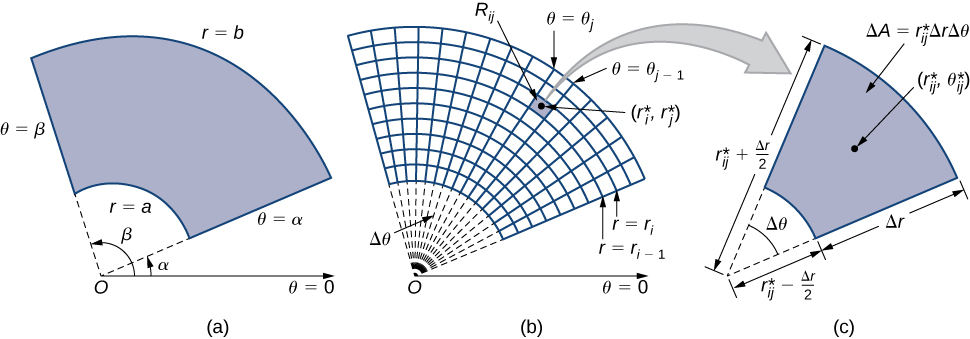
In this section, we are looking to integrate over polar rectangles. Consider a function f(r,θ) over a polar rectangle R. We divide the interval [a,b] into m subintervals [ri−1,ri] of length Δr=(b−a)/m and divide the interval [α,β] into n subintervals [θi−1,θi] of width Δθ=(β−α)/n. This means that the circles r=ri and rays θ=θi for 1≤i≤m and 1≤j≤n divide the polar rectangle R into smaller polar subrectangles Rij (Figure 9.3.1b).
As before, we need to find the area ΔA of the polar subrectangle Rij and the “polar” volume of the thin box above Rij. Recall that, in a circle of radius r the length s of an arc subtended by a central angle of θ radians is s=rθ. Notice that the polar rectangle Rij looks a lot like a trapezoid with parallel sides ri−1Δθ and riΔθ and with a width Δr. Hence the area of the polar subrectangle Rij is
ΔA=12Δr(ri−1Δθ+r1δθ).
Simplifying and letting r∗ij=12(ri−1+ri), we have ΔA=r∗ijΔrΔθ.
Therefore, the polar volume of the thin box above Rij (Figure 9.3.2) is
f(r∗ij,θ∗ij)bΔA=f(r∗ij,θ∗ij)r∗ijΔrΔθ.
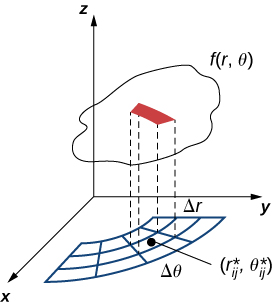
Using the same idea for all the subrectangles and summing the volumes of the rectangular boxes, we obtain a double Riemann sum as
m∑i=1n∑j=1f(r∗ij,θ∗ij)r∗ijΔrΔθ.
As we have seen before, we obtain a better approximation to the polar volume of the solid above the region R when we let m and n become larger. Hence, we define the polar volume as the limit of the double Riemann sum,
V=limm,n→∞m∑i=1n∑j=1f(r∗ij,θ∗ij)r∗ijΔrΔθ.
This becomes the expression for the double integral.
Definition: The double integral in polar coordinates
The double integral of the function f(r,θ) over the polar rectangular region R in the rθ-plane is defined as
∬Rf(r,θ)dA=limm,n→∞m∑i=1n∑j=1f(r∗ij,θ∗ij)ΔA=limm,n→∞m∑i=1n∑j=1f(r∗ij,θ∗ij)r∗ijΔrΔθ.
Again, just as in section on Double Integrals over Rectangular Regions, the double integral over a polar rectangular region can be expressed as an iterated integral in polar coordinates. Hence,
∬Rf(r,θ)dA=∬Rf(r,θ)rdrdθ=∫θ=βθ=α∫r=br=af(r,θ)rdrdθ.
Notice that the expression for dA is replaced by rdrdθ when working in polar coordinates. Another way to look at the polar double integral is to change the double integral in rectangular coordinates by substitution. When the function f is given in terms of x and y using x=rcosθ,y=rsinθ, and dA=rdrdθ changes it to
∬Rf(x,y)dA=∬Rf(rcosθ,rsinθ)rdrdθ.
Note that all the properties listed in section on Double Integrals over Rectangular Regions for the double integral in rectangular coordinates hold true for the double integral in polar coordinates as well, so we can use them without hesitation.
Example 9.3.1A: Sketching a Polar Rectangular Region
Sketch the polar rectangular region
R={(r,θ)|1≤r≤3,0≤θ≤π}.
Solution
As we can see from Figure 9.3.3, r=1 and r=3 are circles of radius 1 and 3 and 0≤θ≤π covers the entire top half of the plane. Hence the region R looks like a semicircular band.
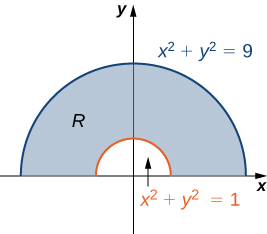
Now that we have sketched a polar rectangular region, let us demonstrate how to evaluate a double integral over this region by using polar coordinates.
Example 9.3.1B: Evaluating a Double Integral over a Polar Rectangular Region
Evaluate the integral ∬R3xdA over the region R={(r,θ)|1≤r≤2,0≤θ≤π}.
Solution
First we sketch a figure similar to Figure 9.3.3, but with outer radius r=2


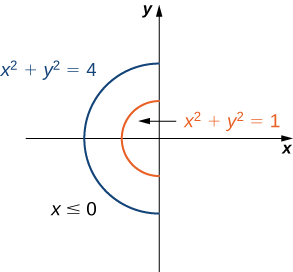
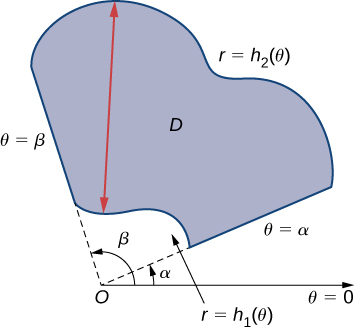
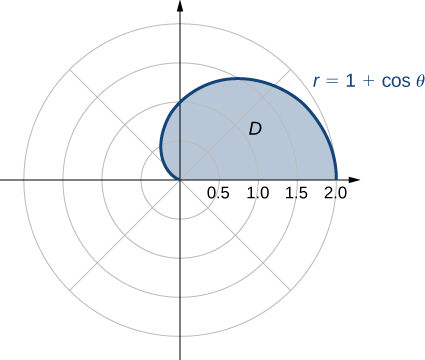
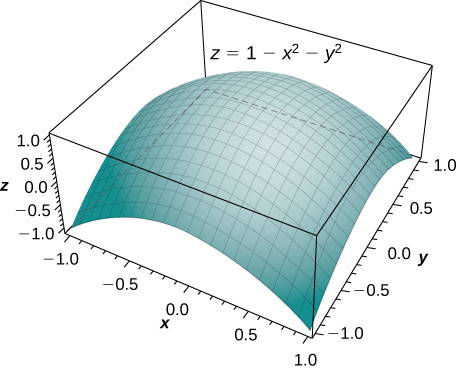
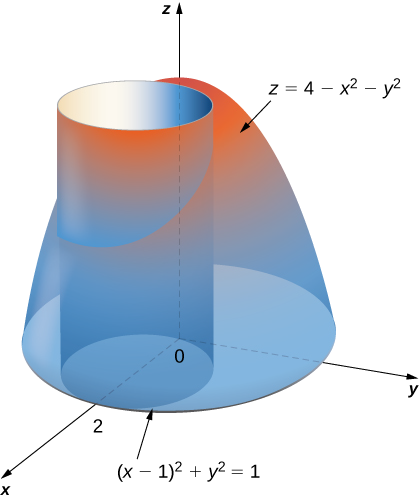
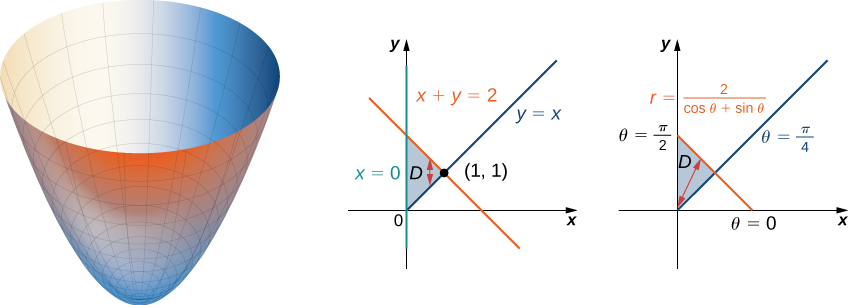
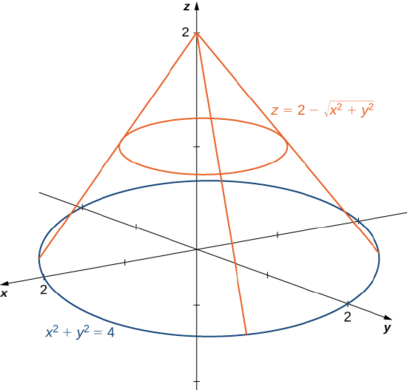
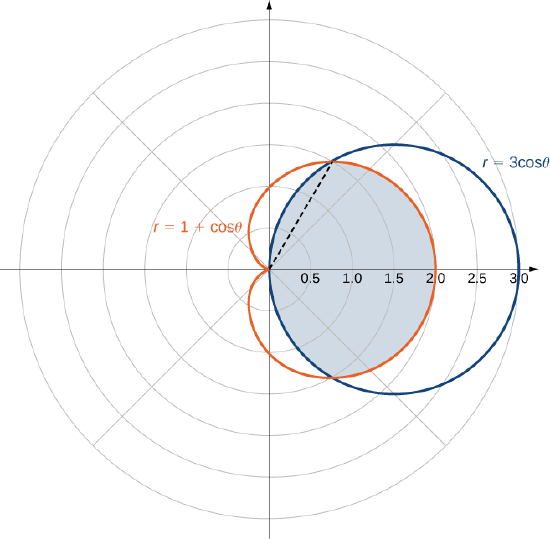
As with rectangular coordinates, we can also use polar coordinates to find areas of certain regions using a double integral. As before, we need to understand the region whose area we want to compute. Sketching a graph and identifying the region can be helpful to realize the limits of integration. Generally, the area formula in double integration will look like
Area ofA=∫βα∫h2(θ)h1(θ)1rdrdθ.
Example 9.3.6A: Finding an Area Using a Double Integral in Polar Coordinates
Evaluate the area bounded by the curve r=cos4θ.
Solution
Sketching the graph of the function r=cos4θ reveals that it is a polar rose with eight petals (see the following figure).
Using symmetry, we can see that we need to find the area of one petal and then multiply it by 8. Notice that the values of θ for which the graph passes through the origin are the zeros of the function cos4θ, and these are odd multiples of π/8. Thus, one of the petals corresponds to the values of θ in the interval [−π/8,π/8]. Therefore, the area bounded by the curve r=cos4θ is
A=8∫θ=π/8θ=−π/8∫r=cos4θr=01rdrdθ=8∫θ=π/8θ=−π/8[12r2|cos4θ0]dθ∫π/8−π/812cos24θdθ=8[14θ+116sin4θcos4θ|π/8−π/8]=8[π16]=π2units2.